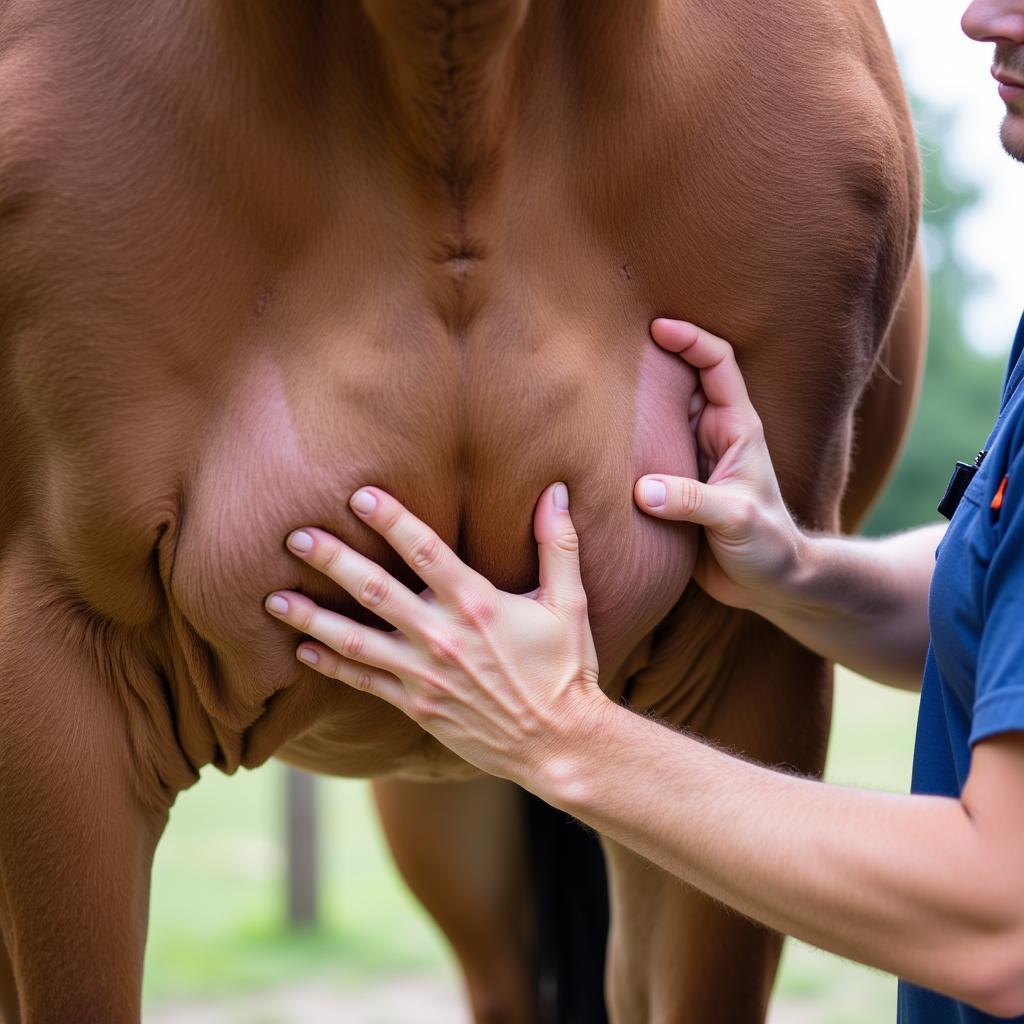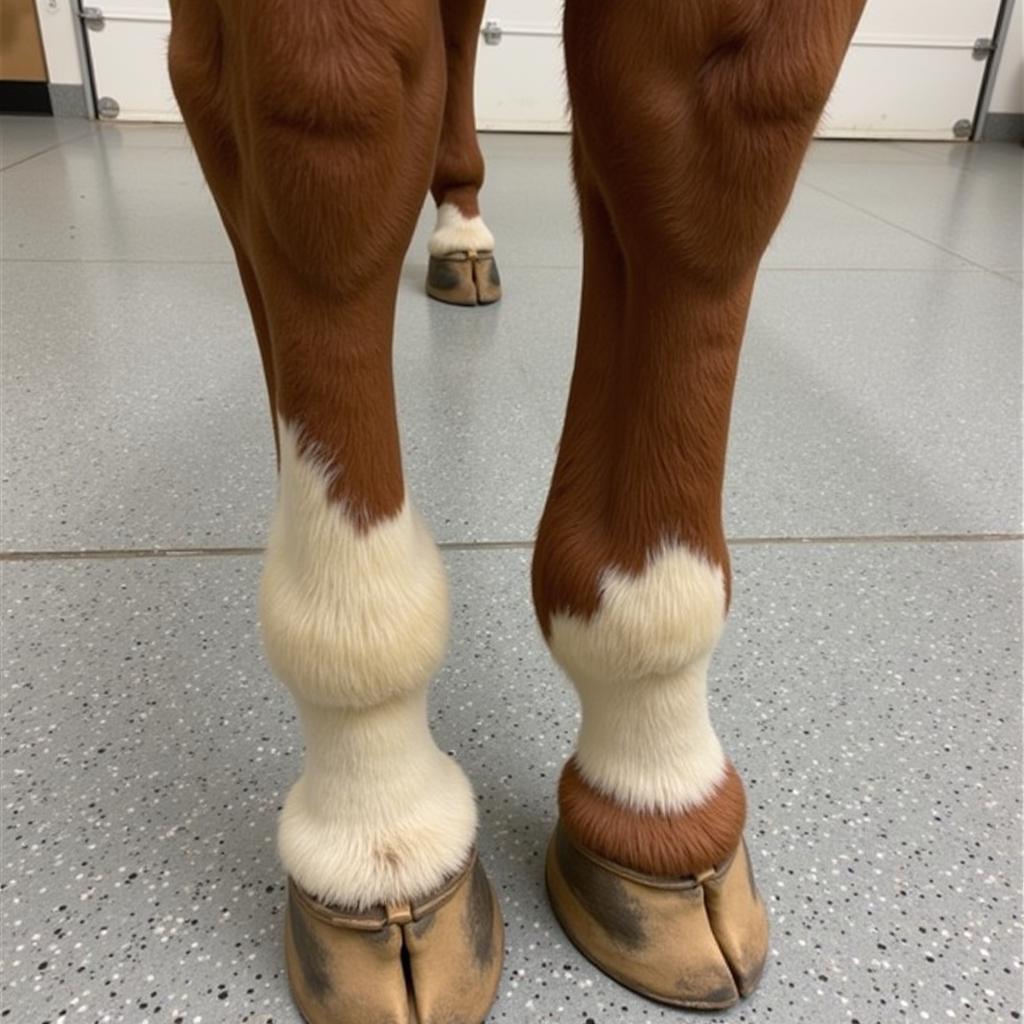Ventral Edema In Horses, also known as dependent edema, refers to the accumulation of fluid in the lower parts of the body, typically the underside of the belly, chest, and legs. This condition can range from mild swelling to significant distension and can be indicative of a variety of underlying health issues. Understanding the causes, symptoms, and treatment options for ventral edema is crucial for horse owners to ensure their equine companions receive appropriate care.
What Causes Ventral Edema in Horses?
Ventral edema develops when the delicate balance between fluid entering and leaving tissues is disrupted. Several factors can contribute to this imbalance, ranging from relatively benign issues to more serious health concerns. Some common causes include:
- Reduced Movement/Standing Still for Long Periods: Horses confined to stalls or with limited turnout can develop ventral edema due to reduced blood circulation and lymphatic drainage. This is often seen in horses recovering from injuries or surgeries.
- Poor Nutrition: Deficiencies in protein and certain minerals can affect the body’s ability to regulate fluid balance, contributing to edema formation.
- Heart Conditions: Certain heart conditions can impair blood flow, leading to fluid buildup in the extremities. This is a serious concern requiring veterinary attention.
- Kidney Disease: Kidney disease can disrupt the body’s ability to filter waste and regulate fluid levels, resulting in edema.
- Liver Disease: Similar to kidney disease, liver disease can also impair fluid balance and contribute to edema formation.
- Parasite Infestations: Heavy parasite burdens can cause protein loss, leading to a decrease in blood protein levels and subsequent edema.
- Allergic Reactions: While less common, allergic reactions can trigger inflammation and fluid accumulation in affected areas.
Recognizing the Symptoms of Ventral Edema
Identifying ventral edema in your horse is often straightforward. The primary sign is noticeable swelling in the lower portions of the body. The skin over the affected area may appear tight and shiny. Pressing gently on the swollen area with your finger can create a temporary indentation, known as pitting edema. While the swelling itself may not be painful, some horses may exhibit signs of discomfort or stiffness, especially if the edema is severe.
Diagnosing and Treating Ventral Edema
If you notice signs of ventral edema in your horse, it’s crucial to consult your veterinarian. They will perform a thorough physical exam and may recommend further diagnostic tests, such as bloodwork and urinalysis, to determine the underlying cause. Treatment for ventral edema depends entirely on the underlying cause.
- Management Strategies: For cases related to reduced movement, increasing turnout time and encouraging exercise can significantly improve circulation and reduce swelling. Providing a balanced diet with adequate protein and minerals is essential.
- Medical Interventions: If the edema is caused by an underlying medical condition like heart or kidney disease, specific treatments will be necessary to address the primary issue. This may involve medications, dietary changes, and other supportive therapies.
 Veterinarian examining a horse for ventral edema
Veterinarian examining a horse for ventral edema
Preventing Ventral Edema
Preventing ventral edema often involves proactive management practices. These include:
- Regular Exercise: Ensure your horse receives adequate exercise and turnout to promote healthy circulation and lymphatic drainage.
- Balanced Nutrition: Feed a high-quality diet that meets your horse’s nutritional requirements, including sufficient protein and minerals.
- Parasite Control: Implement a regular deworming program to minimize the risk of parasite-related edema.
- Veterinary Checkups: Schedule routine veterinary checkups to monitor your horse’s overall health and identify potential problems early on.
Ventral Edema: What You Need to Know
While ventral edema can be a concerning sign, it’s not always indicative of a severe problem. However, it’s essential to address any swelling promptly to prevent complications and ensure your horse’s well-being. Early diagnosis and appropriate treatment are key to a positive outcome.
 Horse with healthy legs after ventral edema treatment
Horse with healthy legs after ventral edema treatment
What is the most common cause of ventral edema in horses?
Lack of movement and prolonged standing are the most frequent causes of ventral edema in horses.
Can ventral edema be serious?
While sometimes benign, ventral edema can be a symptom of serious underlying conditions like heart or kidney disease.
How can I prevent ventral edema in my horse?
Ensure adequate exercise, provide a balanced diet, implement a regular deworming program, and schedule routine veterinary checkups.
Conclusion
Ventral edema in horses is a condition characterized by fluid accumulation in the lower body. Understanding the potential causes, recognizing the symptoms, and seeking timely veterinary care are essential for effective management and treatment. By implementing preventative measures and addressing any swelling promptly, you can help safeguard your horse’s health and well-being. For any further concerns, please do not hesitate to contact us.
Frequently Asked Questions
- Is ventral edema painful for horses? While the swelling itself isn’t usually painful, it can cause discomfort and stiffness.
- How is ventral edema diagnosed? Veterinarians diagnose ventral edema through a physical exam, often including a check for pitting edema, and may use additional tests like bloodwork and urinalysis.
- Can ventral edema be treated at home? Treatment depends on the underlying cause, and it’s crucial to consult a veterinarian before attempting any home remedies.
- What are the long-term effects of untreated ventral edema? Untreated ventral edema can lead to complications depending on the underlying cause, emphasizing the importance of seeking professional help.
- Are certain breeds of horses more prone to ventral edema? While no specific breed is inherently more susceptible, factors like conformation and individual health conditions can play a role.
- Can ventral edema be a recurring problem? Yes, ventral edema can recur, especially if the underlying cause isn’t fully addressed or managed effectively.
- How quickly does ventral edema respond to treatment? The response time varies depending on the cause and the implemented treatment strategy.
For further information or assistance, please don’t hesitate to contact us: Phone: 0772127271, Email: [email protected] or visit us at QGM2+WX2, Vị Trung, Vị Thuỷ, Hậu Giang, Việt Nam. We have a 24/7 customer support team.